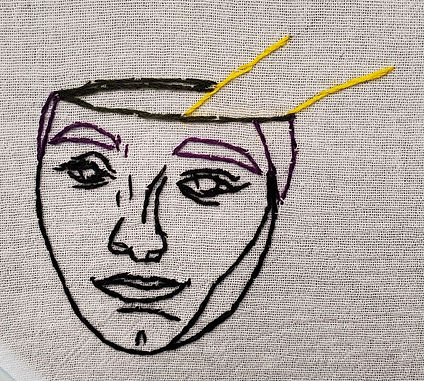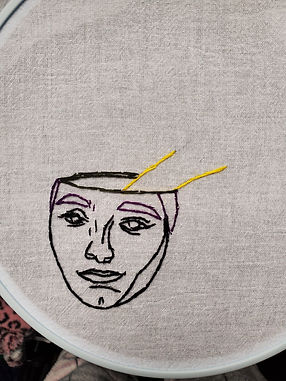Julius Yax

Art Journal 1:
Teaching Philosophy
1/29/2023
For this first art journal entry, it felt right to do a self-portrait of some kind, maybe to reflect upon in later journals. This embroidered piece has something pouring from my head. Knowledge? Creativity? To be later explored.


10 important things to consider when teaching art.
-
Create a space for students to feel safe and feel like they belong.
-
Make sure the students know that the studio belongs to them.
-
Making sure students know that they can make “bad” art.
-
Have high but individualized expectations.
-
Care more about thoughtful and creative conceptualization than having the technical ability to translate it.
-
Everyone learns skills and techniques at their own pace.
-
The making process is vastly more important than the finished piece
-
Art is collaborative.
-
Have a reason to be teaching what you’re teaching.
-
It is vital to keep your own art practice alive.
Why did I include these 10 things?
I decided on this list as a combination of theories I’ve learned in art education and past experiences in my high school classrooms, art and non-art rooms alike.
I first and foremost believe that it is impossible to authentically create work if you feel unsafe or unwelcome in your environment. High school is a time when students are transitioning into adulthood and discovering who they are and what they believe in. They are separating their values and beliefs from their parents' and aligning more with their friends and others they associate themselves with. A very confusing and tumultuous time, and more than anything they need a safe and welcome place to be confused and passionate in. To be as open and free or closed and reserved as they want. My AP Art class was the closest I had experienced to this concept in high school and along with safety and freedom came mutual trust from the teacher. We were given free rein to all materials with eh expectation that we were respectful, careful, and finished the year with an AP portfolio. I wish to carry on the idea that the studio belongs to the students, not me. Not only does this come with the expectation that they keep their space clean and organized but that they can take pride in their own and others’ creations in their shared space, I am simply a facilitator of the creative process and someone to help develop certain techniques and skills if needed. This idea was introduced to me in the form of the teaching philosophy TAB (Teaching for Artistic Behavior) and the main tenants of this philosophy are: The child is the artist, the classroom is their studio, what do artists do? It will take some transitioning to incorporate this artistic philosophy into a high school classroom but I think it can be done and I get super excited just thinking of the possibilities and the works that have yet to be created.
Making sure students know they can make “bad” art is important to me. I never felt like I had room to truly explore and experiment with new media or techniques before being expected to make the final piece. Because of that, I was often disappointed with my outcome. I didn’t feel it reflected my abilities as an artist. I would often times learn while creating the final so my pieces were very unbalanced with one part being very refined and another looking unfinished or out of place. By giving the students time and trust so they can become familiar with the material or technique before having to use it, I am hoping I can better regulate or completely remove the gap between their abilities and what they produce. There is something so freeing about being able to let go of harsh expectations and being able to have fun with the materials and the art-making. If that means you let yourself make some “bad” art for a few days to build up confidence, then that’s what it means.
There will be high and individualized expectations for my students. The expectations aren’t so much on the production or skill level of the student as it is on the ability to creatively conceptualize. 90% of my art classroom experience in K-12 was being told what to make, how to make it, how long it must take, and with what to make it with. So much so that when I took AP Art and then went to college, the freedom and open-endedness was overwhelming. I thought I was able to creatively brainstorm but it turns out, I was only able to follow templates that were laid out for me. Not only is my approach better for the students who wish to pursue art after high school like I did, but for everyone, there is not a single major or job out there that you wouldn’t be easier if you had the ability to break out of the box and creatively brainstorm solutions. Regardless of your future career, so much of making art is the ability to visually translate something internal. Passions, feelings, ideas, messages, pains, traumas, experiences, hopes, everything. Doing that takes communication, self-discovery, and emotional intelligence. Skills that just make us better, more worldly, and more empathetic people. I care a million times more about that than I do if you can render a face with photorealism.
Art is collaborative. You can create and make art all by yourself but it will be worse and less enjoyable than with an artistic community. We need people to bounce ideas off of, to help brainstorm solutions, ask for advice, give critique, and to complain with, if nothing else. I want to build a space where students are free to collaborate and communicate with each other to elevate everyone’s work.
The last two on the list are more just so I can keep my core teaching values in place. I fully believe in being able to defend why your students should learn the lesson you’re teaching them. Nothing would make me less motivated in school than feeling like it didn’t matter if I understood or not. The reason doesn’t necessarily have to be practical or realistic for everyone but there should be a reason. For example, I took calculus in my senior year of high school. I knew I wasn’t going into STEM but I wanted the credits so I wouldn’t have to take math in college. Calculus can be theoretical at times and it was hard for me to imagine a situation where this math would be used in the real world, so I asked. He explained that it’s used for certain types of aerospace engineering and explained the exact situation it would be used for. Even though I had no interest in aerospace engineering I respected that he gave us a real answer as opposed to, “Well, you chose this class, you knew how hard it was.” I strive to do the same thing in my classroom. To only make lessons that I could put up a reasonable defense to students, admin, and parents if I have to.
Lastly, keeping my art practice alive while teaching is something I hold near and dear to my heart. I always respected teachers who practiced what they preached and this is especially relevant in an art classroom. Why would they trust me to teach them if they know I don’t make art anymore?